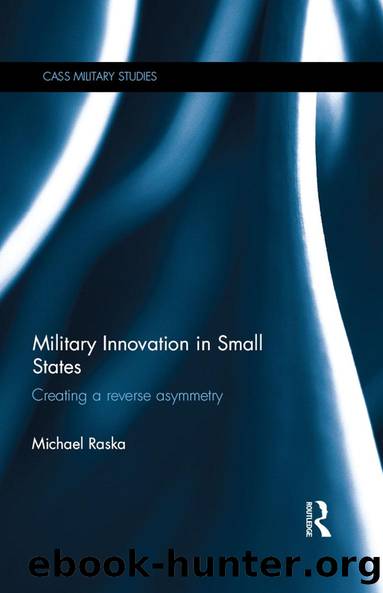Military Innovation in Small States by Michael Raska

Author:Michael Raska [Raska, Michael]
Language: eng
Format: epub
Tags: History, Military, General, Strategy, Political Science, Security (National & International), International Relations
ISBN: 9781317661306
Google: z7nhCgAAQBAJ
Publisher: Routledge
Published: 2015-11-06T16:11:59+00:00
Three pillars of South Koreaâs defense strategy
The above conditioning factors have subsequently defined South Koreaâs defense strategy and its three key pillars: (1) defensive deterrence, (2) U.S.âROK alliance, and (3) forward active defense. While their core characteristics have not been codified or explicitly presented in any official âKoreanâ strategic doctrines, its contours can be extrapolated from analyses of ROK defense white papers and a range of studies concomitant with South Koreaâs national security issues and defense planning dynamics during and post-Cold War (Clough 1976; Johnson and Yager 1979; Curtis and Han 1983; Lee, McLaurin, and Moon 1988; Olsen 1988; Simon 1993; Blackwill and Dibb 2000). The first pillar underscoring South Koreaâs traditional defense strategy â defensive deterrence â emphasizes two objectives: deterring military threats in peacetime and defending South Korea in wartime (Han 1999). In other words, the strategy implies preventing a major war by effectively deterring North Korea-initiated military provocations and, if deterrence fails, winning the war. According to the 1994 ROK defense white paper, âthe enemyâs will to provoke war can be undermined only when our own stance shows clearly that we are capable of and will employ an effective deterrence in times of contingencyâ (ROK Ministry of National Defense [MND] 1995, 84). Defensive deterrence thus stipulates the need for a âvisible combat capability that would deter any offensive military moves by North Koreaâ (Moon 2000, 96). In the context of South Koreaâs traditional security paradigm, visible combat capability essentially means the primacy of conventional ground forces â the ROKA, which has accounted for the majority of South Koreaâs total military manpower and dominated strategic and operational planning, resource allocation, and force structure. The ROKA has trained to counter a potential North Korean attack immediately by blocking KPAâs first echelon forces, defending the capital and rear areas, and executing coordinated air-ground attacks from the initial stages of war â prior to the arrival of U.S. reinforcements (Han 1999).
In order to amplify a credible defensive deterrent posture, the second element in South Koreaâs traditional military strategy has focused on effective external management, coalition-style warfare, and bilateral alliance with the United States. According to Chung-in Moon, âif South Korea was to survive in the tough security environment, effective external management was as critical as military self-help because of the countryâs inherent military weakness ⦠military deterrence through the alliance with the U.S., therefore, was the backbone of South Koreaâs external security management during the Cold War, limiting the utility of other alternativesâ (1998, 270). Codified in the framework of the 1953 U.S.âROK Mutual Defense Treaty, operationalized through the U.S.âROK Combined Forces Command (CFC), created in 1978, and, perhaps more importantly, solidified through the tangible presence of U.S. forces in South Korea (USFK â 2nd Infantry Division, 8th Army, 7th Air Force, and an array of C3I networks), the U.S.âROK security cooperation has served as âthe fundamental axis for security on the Korean Peninsulaâ (ROK MND 1996, 108). Any major scenario of North Koreaâs military aggression would automatically activate U.S. involvement
Download
This site does not store any files on its server. We only index and link to content provided by other sites. Please contact the content providers to delete copyright contents if any and email us, we'll remove relevant links or contents immediately.
The Radium Girls by Kate Moore(10923)
The Templars by Dan Jones(4197)
100 Deadly Skills by Clint Emerson(4090)
Rise and Kill First by Ronen Bergman(4026)
The Doomsday Machine by Daniel Ellsberg(3742)
The Rape of Nanking by Iris Chang(3530)
Killing England by Bill O'Reilly(3466)
Hitler in Los Angeles by Steven J. Ross(3450)
Stalin by Stephen Kotkin(3094)
12 Strong by Doug Stanton(3064)
Hitler's Monsters by Eric Kurlander(2740)
Darkest Hour by Anthony McCarten(2655)
Blood and Sand by Alex Von Tunzelmann(2615)
The Art of War Visualized by Jessica Hagy(2424)
Hitler's Flying Saucers: A Guide to German Flying Discs of the Second World War by Stevens Henry(2305)
The Code Book by Simon Singh(2222)
The Second World Wars by Victor Davis Hanson(2140)
Babylon's Ark by Lawrence Anthony(2077)
Tobruk by Peter Fitzsimons(2068)
